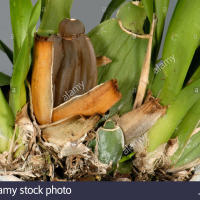Phytophthora trunk rot
Phytophthora cactorum
P. cactorum attacks the roots and trunk of apple and pear trees. Although it is rarely a problem in pear, Phytophthora crown, collar, and root rot is a major problem in apple orchards. Crown rot occurs when the infection is below the soil line, and typically affects the rootstock. Collar rot occurs above the soil line on the lower trunk of the scion. In both cases foliar symptoms are indicative of root or vascular dysfunction. Affected trees exhibit poor terminal growth and become stunted. Upon removal of the periderm, the inner phloem tissue is typically necrotic and orange- to red-brown, and may be dark brown during latter stages of infection. Trees infected with either of these diseases usually decline over several seasons and eventually die.
Phytophthora leaf blight and root rot is a devastating disease which causes a leaf blight and root rot on ginseng. The disease is caused by a fungus, Phytophthora cactorum, which produces spores that are spread by wind, rain, splashing water, and surface water runoff. Root rot is the most serious form of the disease. Therefore, if foliar symptoms are present, preventing spread of the disease from foliage to roots is essential.
Phytophthora leaf blight symptoms begin as dark, water-soaked lesions on the leaf surface. The lesions eventually become papery thin, brown, and dry. The large brown, irregular shaped spots do not have the concentric ring pattern as seen in Alternaria leaf blight lesions (discussed later). During wet, rainy periods, the disease will develop and spread rapidly, resulting in severe blighting of the foliage. The crown, or neck, of the plant may also be affected.
The first symptom of Phytophthora root rot is a wilting plant. Affected root surfaces have a brown discoloration and the interior vascular ring of the root will be darkened. The rest of the root interior, which should be creamy white, will appear beige. In later stages, the root will feel soft and rubbery, have a foul, rotten odor, and will eventually disintegrate.
P. cactorum overwinters in the soil and on infected roots. The fungus is spread by water and by movement of infested soil on equipment. Disease development is favored by cool, wet, humid conditions and is most severe in poorly drained sites.









Plant Protection Products
- ⭑⭑⭑
- ⭑⭑⭑
- ⭑⭑⭑
- N/A